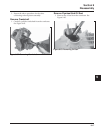
10.4
Section 10
Inspection and Reconditioning
Figure 10-4. Measuring Piston Diameter.
2. Use an inside micrometer, telescoping gauge, or
bore gauge and measure the cylinder bore. Take
the measurement approximately 63.5 mm
(2.5 in.) below the top of the bore and
perpendicular to the piston pin.
3. Piston-to-bore clearance is the difference between
the bore diameter and the piston diameter (step 2
minus step 1).
Flywheel
Inspection
Inspect the flywheel for cracks, and the flywheel
keyway for damage. Replace flywheel if it is cracked.
Replace the flywheel, the crankshaft, and the key if the
flywheel key is sheared or the keyway is damaged.
Inspect the ring gear for cracks or damage. Kohler
does not provide ring gears as a serviceable part.
Replace the flywheel if the ring gear is damaged.
Cylinder Head and Valves
Inspection and Service
After cleaning, check the flatness of the cylinder head
and the corresponding top surface of the crankcase,
using a surface plate or piece of glass and feeler gauge
as shown in Figure 10-5. The maximum allowable out
of flatness is 0.076 mm (0.003 in.).
4. After resizing, check the bore for roundness,
taper, and size. Use an inside micrometer,
telescoping gauge, or bore gauge to take
measurements. The measurements should be
taken at three locations in the cylinder – at the
top, middle, and bottom. Two measurements
should be taken (perpendicular to each other) at
each of the three locations.
Clean Cylinder Bore After Honing
Proper cleaning of the cylinder walls following boring
and/or honing is very critical to a successful overhaul.
Machining grit left in the cylinder bore can destroy an
engine in less than one hour of operation after a
rebuild.
The final cleaning operation should always be a
thorough scrubbing with a brush and hot, soapy
water. Use a strong detergent that is capable of
breaking down the machining oil while maintaining a
good level of suds. If the suds break down during
cleaning, discard the dirty water and start again with
more hot water and detergent. Following the
scrubbing, rinse the cylinder with very hot, clear
water, dry it completely, and apply a light coating of
engine oil to prevent rusting.
Measuring Piston-to-Bore Clearance
Before installing the piston into the cylinder bore, it is
necessary that the clearance be accurately checked.
This step is often overlooked, and if the clearances are
not within specifications, engine failure will usually
result.
NOTE: Do not use a feeler gauge to measure piston-
to-bore clearance–it will yield inaccurate
measurements. Always use a micrometer.
Use the following procedure to accurately measure
the piston-to-bore clearance:
1. Use a micrometer and measure the diameter of
the piston 6 mm (0.24 in.) above the bottom of the
piston skirt and perpendicular to the piston pin.
See Figure 10-4.
6 mm (0.24 in.)
Measure 6 mm above the
Bottom of Piston Skirt at
Right Angles to Piston Pin


















